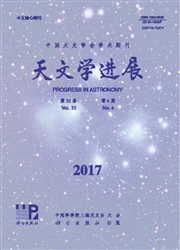

 中文摘要:
中文摘要:
利用天体光谱上DLAs系统吸收线测定星际或星系际介质的金属元素丰度,是研究星系际介质和星系化学演化的基础。目前主要有三种测定元素柱密度的方法:生长曲线法、谱线轮廓拟合法和视光深法。古老的生长曲线法目前主要应用于光谱分辨率不高的观测,而且常常只用于气体云光学薄的情形,但是这种方法不受仪器轮廓的影响。在当今光谱分辨率观测普遍较高以及计算机技术相当发达的情况下,谱线轮廓拟合法和视光深法获得了更多的应用,尤其是谱线轮廓拟合法。只是它有较多的自由参数需要确定,从而需要大量的计算时间,有时会出现几个不同收敛解的情况;另外,在谱线混合严重的情况下这种方法也会引入较多的偏差。至于介于这两种方法之间的视光深法,由于简单而可靠,当今也受到部分研究者的偏爱;只是由于谱线隐性饱和的存在,使这种方法的应用受到限制。
 英文摘要:
英文摘要:
In the first of our series review paper about Damped Lyman Alpha systems(DLAs), we have mainly given a detailed introduction to the recent progress in DLA surveys.In this second paper of the series, we will review the main methods of measuring the metal column density in the gas clouds along the line of sight towards the background QSOs.There are three main methods of measuring the metal column density of gas clouds:Curve of Growth; Line Profile Fitting and Apparent Optical Depth methods. The method of Curve of Growth(COG) was developed in about half a century ago. So far it has been mainly applied in observations with the low spectral resolution. Though the COG is unaffected by the instrumental profile, it is widely used in the case of optical thin gas clouds. In recent years, most of the observations are done with high resolution spectrographs, therefore the acquired spectra are of very high spectral resolution. In this case the Line Profile Fitting method(LPTM) and the Apparent Optical Depth method(AODM) are more frequently adopted by most of astronomers. The LPTM is often used in measuring the column densityof gas, but it has more fitting parameters. So, it will consume more time of calculation and sometimes will result in several convergence solutions. It will also introduce more deviations when a line is blended seriously with other lines. The AODM is adopted by some groups since it is more simple and reliable in some cases. But this method suffers from the indirect line saturation in spectra, so it is only used in some special cases.
 同期刊论文项目
同期刊论文项目
 同项目期刊论文
同项目期刊论文
 AutomatedIdentification of 2612 Late-K and M Dwarfs in the LAMOST Commissioning DataUsing Classifica
AutomatedIdentification of 2612 Late-K and M Dwarfs in the LAMOST Commissioning DataUsing Classifica Progress in Research of Damped Lyman Alpha Systems (DLAs)(II): Methods of Measuring the Metal Column
Progress in Research of Damped Lyman Alpha Systems (DLAs)(II): Methods of Measuring the Metal Column 期刊信息
期刊信息
